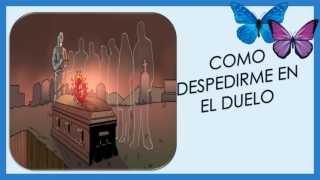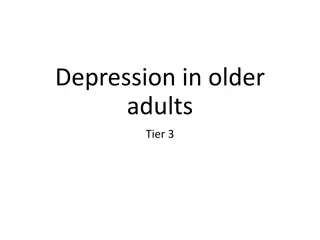Understanding Grief vs. Depression: A Guide for Supporting Students
Grief and depression are complex emotional experiences that can impact individuals differently. This guide provides insights into distinguishing between grief and depression, helping you support students through the grieving process effectively. Learn how to identify signs, educate on the grieving process, encourage expression of feelings, and empower students to move forward positively.
Download Presentation

Please find below an Image/Link to download the presentation.
The content on the website is provided AS IS for your information and personal use only. It may not be sold, licensed, or shared on other websites without obtaining consent from the author. Download presentation by click this link. If you encounter any issues during the download, it is possible that the publisher has removed the file from their server.
E N D
Presentation Transcript
Take a moment and write down what comes to mind when you hear the word depression.
Sadness is just a normal feeling Sadness is an emotional pain associated with, or characterized by, feelings of disadvantage, loss, despair, grief, helplessness, disappointment and sorrow. Sadness
Difference between sadness and depression Sadness lasts for a short period of time, depression can last for weeks or months at a time. Sadness usually does not impact a person s ability to function productively, whereas depression can. Sadness is often times realistic in thought pattern, whereas depressed thoughts can be distorted and unrealistic. Depression involves feelings of hopelessness and helplessness. Depression is an illness.
Sadness vs Depression Depression vs sadness https://www.youtube.com/watch?v=bCI68IfY0D8
Grief Grief is a multifaceted response to loss, particularly to the loss of someone or something that has died, to which a bond or affection was formed.
Grief vs a Major Depressive Episode (DSM5) GRIEF Major Depression Dominant affect is feelings of emptiness and loss Dominate affect is depressed mood. Dysphoria occurs in waves, vacillates with exposure to reminders and decreases with time. Persistent dysphoria that is accompanied by self-critical preoccupation and negative thoughts about the future. Capacity for positive emotional experiences. Limited capacity to experience happiness or pleasure Self-esteem preserved Suicidal ideas about escaping life versus joining a loved one. Fleeting thoughts of joining the deceased.
Helping students in the grieving process. Identify that they are grieving vs depression. Educate on the grieving process Feel- help them identify feelings and express them- good bye letter Let them share their story Help them to move forward
Some resources on grieving. If you are going to work with young children you should be aware of this series: https://www.youtube.com/watch?v=s8M_5_JxY7k Working with Children, Teens, Young adults- Adults- you will want to educate on grieving process. Grieving process https://www.youtube.com/watch?v=mTHchH9VRh0
Depression Depression is a mood disorder that causes a persistent feeling of sadness and loss of interest. https://www.youtube.com/watch?v=7xPnUe6Xcbw
Some Statistics 1 in 5 children will go through a depression before finishing high school 8 of 100 children/teens have a major depression at any point in time. Depression affects 3% of children and 6 8% of adolescents. 2 of 3 depressed teens are girls It is estimated that about 10 to 15 percent of children and teens are depressed at any given time
What causes Depression Family history (genetics) Stress, including: Conflict between parents, or with parents or siblings Depression or too much stress in parents Separation or divorce of parents Conflicts with friends or classmates, Social stress School stress not doing well, or too much pressure Bullying Loss of someone important
When to be concerned. Feeling sad or depressed for more than 2 weeks Increase in irritability and anger. Drastic changes in behavior or personality Not enjoying life, school or activities as much Trouble coping with home, school or work
When to be concerned Severe mood swings affecting ability to function Feeling hopeless or worthless Problems with sleep, appetite, energy and concentration, hygiene. Expressions of wanting to die or plans to harm him/herself
Types of Depression Disruptive Mood Dysregulation Disorder Major Depression Persistent Depressive Disorder Premenstrual Dysphoric Disorder Substance/Medication induced disorder Depression Disorder due to another medical condition Other specified depressive disorder Unspecified depressive disorder Type of depression https://www.youtube.com/watch?v=PbJB02Zlh4w
Mood Disorders Childhood and adolescent depression are real Mood disordersin children and adolescents are among the most common psychiatric disorders 50% of depressed adults had their first episode before age 20 Life events: stresses play a role in timing and onset
Types of mood disorders MDD 6.7% (14.8 mil. 18+), leading cause of disability in the U.S for ages 15-44. Persistent Mood Disorder 1.5% (3.3 mil.) median age of onset = 31 Bipolar D/O 2.6% (5.7 mil.) median age of onset = 25
Comorbidity: MDD High levels of comorbidity are found in both clinical and non-clinical samples (Angold and Costello, 1993) Persistent Depression 30-80% onset age 8 Anxiety disorders 30-75% onset age 6 ADHD/Disruptive Disorders 60% onset age 4 Substance Use/Abuse 20-30% onset age 10 20-80% co-morbid with oppositional/conduct disorder (onset age 7-8)
Depression in Women Women experience depression about twice as often as men. Contributors: Added stressors: Work/life balance Parenting, single-parenting Caring for children and for aging parents Hormonal factors: Changes in menstrual cycle pregnancy, miscarriage, postpartum period, pre-menopause, menopause
Depression in Men Men are less likely to admit, less likely to be detected. 6 million men in the U.S affected. Suicide in men is 4 x that of women (more women attempt). Often masked by AOD, excessively long working hours. Manifests as irritability, anger, discouragement rather than hopelessness/helplessness.
Diagnostic Evaluation Complete history: Of symptoms onset, duration, severity, impairment Prior episode, treatment, remission Type of treatment, response to treatment Current/past SI/HI AOD use, OTC, herbal supplements Family history Medical condition (most recent physical check-up)
Childhood Depression Can Be Treated At least 70% - 80% of kids with depression can be effectively treated Without treatment, 40% will have 2nd episode within 2 years 20% - 40% may go on to develop bipolar disorder Most experience residual symptoms 72% experience recurrent episodes within 5 years
Treatment of Major Depression Treatment methods may include Individual psychotherapy Family therapy Medication
Treatment Consideration Depends on diagnostic evaluation outcome/client s learning style: Psychotherapy precipitating/sustaining factors, adaptive coping strategies (current/past/additional), maintenance/relapse prevention Medication symptoms/functional stability
Treatment Medication Only used when other treatments don t work, or when the depression is so severe that other treatments aren t possible Antidepressants are safe and effective when used correctly and monitored by a doctor
Treatment Young children are most often treated with their family. Working with parents to help them help their child Family therapy if family problems are part of the problem Cognitive Behavioral Therapy is proved to be very effective The child learns ways to manage stress, do things that help her feel better, and think more positively.
Depression Psychopharmacological First Line Treatments Fluoxetine (Prozac) Sertraline (Zoloft) Escitalopram) (Lexapro) Citalopram (Celexa) https://www.youtube.com/watch?v=trnG-vQweEo
CBT CBT for Kids Thought cards
Educate on the basics! Get enough sleep Eat healthy meals and snacks Take vitamin D supplements and consider omega 3 fatty acids Get exercise an hour a day if possible. Get enough sunlight (in winter, vitamin D supplements) Plan enjoyable activities and one on one time with your child Parents need to take care of themselves too!
Some Resources Therapist aid https://www.therapistaid.com/therapy- worksheets/depression/adolescent Rating Scales Patient Health Questionnaire Modified for Teens (PHQ-9) Mood and Feeling Questionnaire (MFQ) Center for Epidemiological Studies Depression Scale for Children (CES-DC) Quick Inventory of Depressive Symptomology (QIDS-A17-C) Treatment https://www.youtube.com/watch?v=f6Ca60l4rgw Cbt https://www.youtube.com/watch?v=PcFmrVZ0e-I























